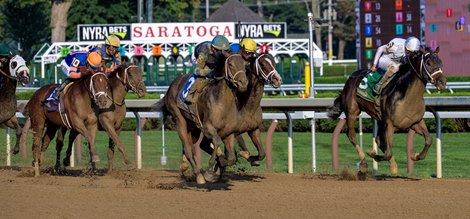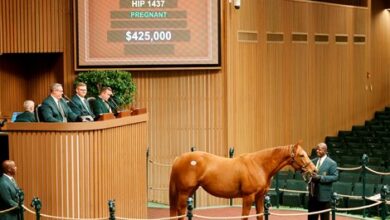HISA Highlights Risk Factors Among Saratoga Fatalities

An in-depth review of circumstances and conditions related to 14 catastrophic breakdowns during racing and training last summer at Saratoga Race Course did not find a clear, common thread among the incidents but rather identified multiple contributing risk factors, according to a report released Feb. 26 by the Horseracing Integrity and Safety Authority.
The spike in fatalities was unusual for the New York racetrack and felt particularly intense with three occurring in graded stakes, two of them in the final furlong of grade 1 stakes. HISA initiated an independent to review to determine what may have contributed to his uncharacteristically high number of breakdowns.
The analysis looked at the condition and maintenance of dirt and turf surfaces, veterinary and exercise histories, necropsy reports, and any potential rule violations.
HISA did not find any rule violations but did identify several contributing risk factors.
Twelve of the 14 horses sustained a musculoskeletal injury, with 10 of the 12 involving a fracture in the fetlock joint. Two horses suffered fractures in a pastern. Three of the horses with fractures received intra-articular corticosteroid injections within 30 days of the injury. One horse was on the vet’s list for unsoundness at the time of the injury, and two had previously been on the vet’s list.
“Appearance on the veterinarian’s list is strongly associated with future fatal injury,” the HISA report stated.
The connection between some of the deceased horses and intra-articular corticosteroid injections gives further support to a HISA proposed rule change that would prohibit fetlock joint injections within 30 days of a race, according to the report. This rule change is being reviewed by the Federal Trade Commission.
Another significant risk factor appeared to be associated with horses that had frequent high-intensity exercise without being given adequate time to recover. Dr. Sue Stover analyzed the lifetime high-speed exercise histories of the 12 horses that died due to musculoskeletal injuries. She compared each deceased horse with three control horses that were similar in age, sex, and quality. Injured horses were found to have more races per year during active racing periods (periods without a layup of more than 60 days) and on average raced more furlongs per month than the control group.
“Based on number of races averaged over one year for periods of active racing, the injured horses were 2.5 times more likely to be injured than control horses,” the report stated.
“The factors observed are consistent with our knowledge of repetitive, overuse (fatigue) injuries in racehorses,” the report continued. “Frequent high-intensity exercise (as observed in injured horses) that does not allow for recovery of exercise-induced microdamage contributes to the development of stress fractures and subchondral stress modeling, which predisposes horses to catastrophic injury.”
The investigation did not find any issues related to the maintenance of the track surfaces, finding the protocols to be consistent with standard operating procedures. No issues were identified either with composition or drainage. The study did note that no musculoskeletal fatalities occurred at the track’s Oklahoma training track on either the dirt or turf during the entire season.

There were musculoskeletal fatalities on Saratoga’s Oklahoma training track on either the dirt or turf during the entire season
The Saratoga meet did see 11.03 inches of rain as compared with 7.76 inches in 2022 and 8.69 inches in 2021. The rain last year forced 65 races to be taken off the turf. The report did not draw a correlation between the increased rainfall and the breakdowns because the first seven fatalities occurred on courses rated as fast or firm.
Still, the report’s conclusion stated the greater rainfall “could not be overlooked.”
“Available data suggest that rainfall could have played a role in the increased risk of fatal injury during the 2023 meet,” it stated.
Pat McKenna, vice president of communications for NYRA, said ensuring safety for horses and riders was the highest priority for NYRA and expressed thanks to HISA for compiling the report.
“Continuously improving equine safety is a fundamental responsibility shared among racetrack operators, regulators, trainers, breeders, and owners. HISA’s review of the 2023 summer meet at Saratoga Race Course enhances our understanding of the myriad factors that may contribute to injuries sustained during training or racing,” he said. “To prevent serious injuries before they happen, NYRA is embracing science and technology to provide veterinarians and trainers with the tools necessary to identify underlying conditions and further reduce the frequency of equine injuries. Beyond the adoption of biometric wearables and artificial intelligence, NYRA is working with the University of Kentucky and Racing Surfaces Testing Laboratory to expand our understanding of how weather conditions impact racetrack performance.”
Going forward, HISA said it has developed with Palantir Technologies a data analytics tool to identify horses at risk for injury to assist trainers in identifying horses that warrant more detailed evaluation.
“We are hopeful that this powerful tool will contribute to a reduction in equine injuries once it is implemented,” the report stated.




